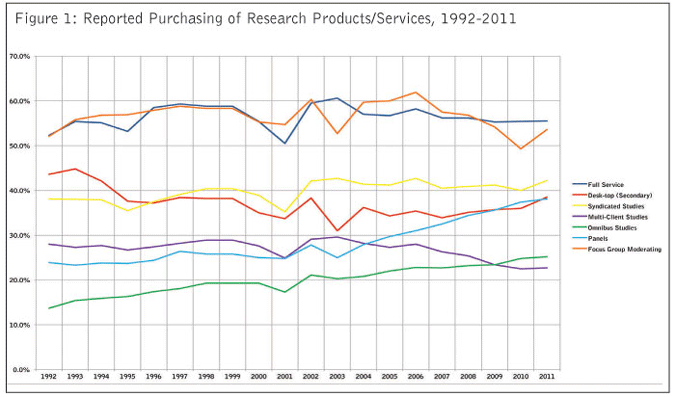Shifts and changes
Over the past 20 years, Quirk’s has kept track of its readership and their research-buying habits. What services are the buyers of research most involved and interested in? What are their areas of research involvement? By asking these questions as part of our circulation management process we’ve been able not only to tailor our content to best suit the majority of our readers but also to track trends in corporate research: What industries are picking up their research-buying? What are people doing more of? Less? What can this tell us about the journey the research industry has taken? Or about the decades to come?
Quirk’s new and existing subscribers are asked each year about their role in the research industry (i.e., job title); their involvement in different industries (i.e., consumer, non-durable; consumer, durable; services; business-to-business; and health care); and what research products and services they purchase - from full-service research, syndicated studies and personal interviewing to panels, focus group moderating and statistical analysis.
Didn’t suffer as badly
All the talk of research having suffered a serious blow during the Great Recession was not entirely imagined although many areas that were reportedly hit the hardest didn’t suffer as badly as hyped, according to what our buyer-side readers reported.
Aside from online services, panels and omnibus studies, reported use among client-side researchers of nearly all other research products and services purchased fell off after 2008, with the biggest declines in telephone interviewing, mail surveys/lists, mall intercepts, focus group moderating and the purchasing of software packages and data services. Research buyers appear to have been investing their energy into more bang-for-your-buck services and software like secondary research, omnibus studies, panels and online interviewing - all of which increased from 2008 to 2011.
However, the ease and affordability of online panels and omnibus services have not detracted from interest in full-service market research services. Despite a 5 percent drop in 2001, followed immediately by an almost 10 percent increase in 2002 and continued into 2003, full-service research has maintained involvement around 55 percent for the past five years (Figure 1).

Corporate researchers’ buying of focus group recruiting and/or facilities has held tight near 60 percent for the past decade, despite talk of qualitative being hit the hardest during the last economic downturn. Reported use of focus group moderating, however, declined over 8 percent in the past five years. This decrease could be in line with a downturn in qualitative research or general use of non-moderators for moderating.
Desktop or secondary research was on a somewhat steady downward trend, bottoming out at 31 percent in 2003, but it has slowly crept back up since 2007, perhaps as a cost-saving measure when custom research was not affordable in a suffering economy.
A meteoric rise
Not surprisingly, online interviewing has seen a meteoric rise - nearly 40 percent! - since we began tracking it in 2004. The 7 percent rise in reported panel-buying may also be attributed to panels moving more and more to online platforms, making it easier for corporate researchers to engage and manage panelists. Both telephone interviewing and mail surveys appear to have suffered some at the hands of all things electronic and online, with each dropping off drastically in 2006.
When it comes to data processing and software buying, online has dominated since 2004 (Figure 2). Use of data processing services (30.6 percent), statistical analysis (49.4 percent) and software packages (30.9 percent) have been usurped by the rise in online interviewing software (62.6 percent). Buying of online interviewing software is more than double data processing services and software packages combined and 13.2 percentage points ahead of statistical analysis software.

Hasn’t been the full replacement
Although research activities online have gained popularity, they haven’t been the full replacement that many feared when they first came on the scene. (Perhaps a predictor of social media research’s trajectory among our audience?) Overall, from 1992 to 2011 reported use of telephone interviewing has only declined 7.9 percent (Figure 3). However, mail has fared far worse than telephone interviewing, declining a full 20 percent in the past 20 years among our audience.

Dwindling interest
Along with the dwindling interest in snail-mail research products and services, Quirk’s buyer-side readers are the least involved with mall intercepts. Mall intercept research is reportedly purchased the least (compared to personal interviewing, telephone interviewing, mail surveys/lists and focus group recruiting/facilities), although it saw spikes in buying in 2011 and 2003. Since 2003 buying of mall intercept services/interviewing has dropped off 5.4 percent, making it the least-popular by nearly 25 percent.
Overall gradual rise
Our client-side readership has seen an overall gradual rise in researchers involved in all industries. Involvement in the consumer non-durables industry began at 30.8 percent in 1992, hitting 40 percent in 2005 and staying around there for the next six years (41.3 percent in 2011) (Figure 4). Corporate researchers involved in the services industry has also seen an increase of 7.7 percent since 1992. Health care research involvement, however, is the only industry that reached its all-time high in 2011 at 27.5 percent. This number is comparable to consumer durables but still significantly lower than consumer non-durables, services and business-to-business.

Room for everyone
Tracking the usage activities of client-side researchers over the past 20 years has presented an opportunity for Quirk’s to explore emerging trends, dying breeds and hot-button issues in the industry in hopes of bringing our readers the most relevant content possible. If the past two decades are any indication, it seems that regardless of what next big thing is on the horizon there is - and will continue to be - room for everyone and every discipline.
